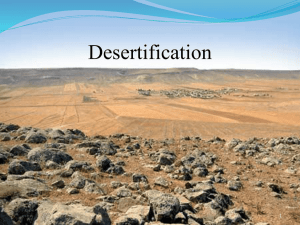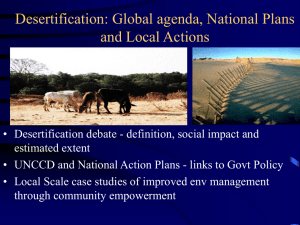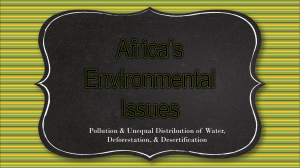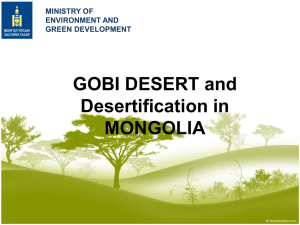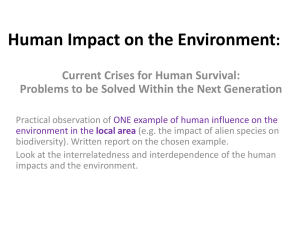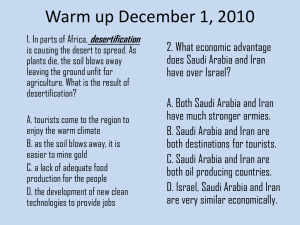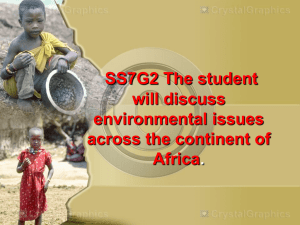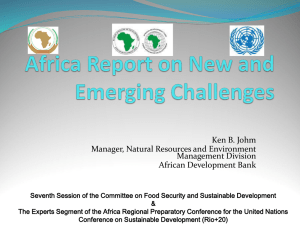Project efficiency
advertisement
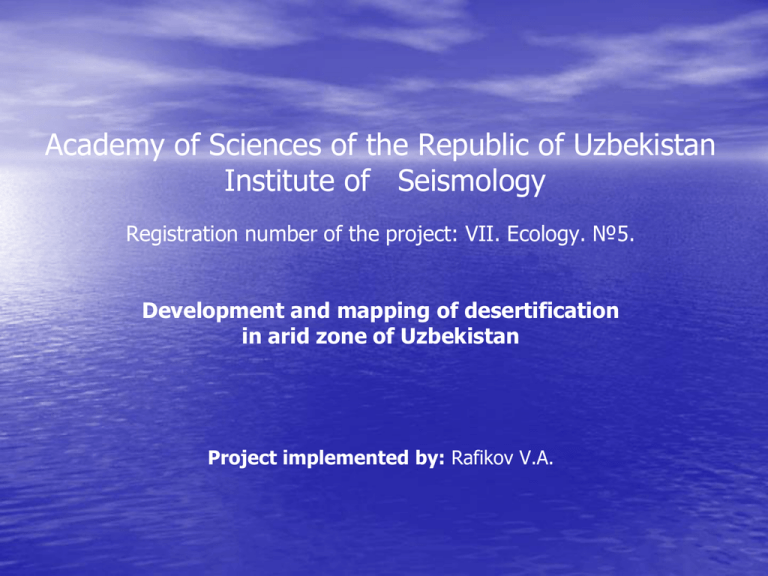
Academy of Sciences of the Republic of Uzbekistan Institute of Seismology Registration number of the project: VII. Ecology. №5. Development and mapping of desertification in arid zone of Uzbekistan Project implemented by: Rafikov V.А. Project efficiency: To ensure the fulfillment of the decree of the President of the Republic of Uzbekistan I.A. Karimov No. PP-2125 "On improvement of activity of the Uzbek Scientific Production Center of Agriculture", dated February 20, 2014, which clearly sets a task – “to take steps to expand and improve the quality of scientific research in the field of: rational use of land and water resources, fertility and efficiency improvement of irrigated lands and dry lands, forests, mountainous and desert areas and pastures”; “development in a systematic manner for each territory of the Republic of special maps on the agriculture development reflecting existing problems and science-based solutions on reclamation and soil fertility improvement, introduction of intensive agricultural technologies of crops cultivation, increase profitability and reduce costs in the agricultural production”. Project scope: To identify the main factors of desertification in the arid zone of Uzbekistan; to assess their current status; to identify the main stages of development; to identify trends and substantiate the basic laws of desertification; to develop measures preventing desertification in arid zone of Uzbekistan by geo-environmental regulation to reduce the risk and mitigate the consequences of natural and manmade disasters; to develop a “Map of desertification in arid zone of Uzbekistan” on a scale of 1: 1 000 000. Objectives of the project: 1) assessment of natural conditions for the development of desertification in the arid zone of Uzbekistan; 2) establishment of desertification factors; 3) analysis of the current state of desertification on rangeland and irrigated ecosystems, their assessment and substantiation of forecast; 4) mapping of desertification; 5) development of methods for the desertification prevention; 6) determination of the scientific and practical basis to optimize the environment of desertification territories. 7) development of a “Map of desertification in arid zone of Uzbekistan” on a scale of 1: 1 000 000. The main stages of the project implementation: In 2014: 1. Evaluation of the natural conditions of the region for the development of desertification; 2. Establishment of the factors of desertification; 3: Determination of the main indicators, criteria, classes and types of desertification; 4. Develop a methodology for mapping of desertification; 5. Set the main stages in the development of anthropogenic desertification; 6. Identify trends in the development of desertification; 7. Substantiate the basic laws of development of desertification. In 2015: 1. Specification of the resources needed to solve the problem; 2. Evaluation of Project Alternatives; 3. Develop measures to prevent the desertification in the arid zone of Uzbekistan by geo-environmental regulation to reduce the risk and mitigate consequences of natural and man-made disasters. In 2016: 1. Develop a “Map of desertification in arid zone of Uzbekistan” on a scale of 1: 1 000 000; 2. System design measures to prevent the desertification processes in arid zone of Uzbekistan; 4. The effectiveness of the program and the organizational and technical measures for its implementation Expected results and impact of the project execution: 1) “Map of desertification in arid zones of Uzbekistan” on a 2) 3) 4) scale of 1: 1 000 000; “Map of desertification risk in arid zone of Uzbekistan” on a scale of 1: 1 000 000; The system of practical measures to prevent the desertification in the arid zone of Uzbekistan; The effectiveness of the program and the organizational and technical measures for its implementation. Methods, tools and objects of study. • • • • Desertification is a typical arid physical-geographical process, developing under the influence of a complex of different factors. Therefore, during the study of desertification one of integrated approaches – landscape-environmental, shall be applied, which allows accounting for all factors and objective reasons that contribute to the dynamics of desertification in space and in time. J.A. Mabbut (2009), B.A. Alekseev et al. (2011) wrote on the application of a landscape approach in the study of desertification. However, since desertification is often associated with the degradation of ecosystems and in whole of the wildlife, and on the next stages - and inanimate nature, it is advisable to apply landscape and ecological approaches in conjunction, it is also will be correct in the structural and genetic aspect. The methodology is based on a landscape-ecological analysis of structural and dynamical state of natural complexes that change in the result of economic activity of the population. Identification of current particular condition and trend of geo - and agro-ecosystems under the influence of anthropogenic factor as a result of the expedition, display, mapping, remote, analytical, landscape, environmental and other methods application will allow to accurately identify and map types, classes, and the risk of desertification in arid zone of Uzbekistan. Among them, the most productive research methods are satellite indicative, landscape indicative, and evaluation. Reliable interpretation of satellite images of medium scale (1: 500 000; 1: 200 000) allows identifying the contours of geosystems with different natural drainage conditions that is necessary for the development of relevant event system technologies. For the successful implementation of the project, there are basically all the research facilities, in particular, modern computer equipment and accessories, government cartographic materials, descriptions of landscapes, the statistical materials of observation a regime of number of natural phenomena and processes, and others in the arrangement of the laboratory. There is scientific basis on this issue in the laboratory of Regional Geography in the Institute of Seismology of Academy of Sciences of the RUz, since starting from 1977 regular researches on the optimization of the natural environment in the Aral Sea and the Aral Sea region and on the impact of economic activities on the natural environment by some regions to identify their geographical, environmental and socio-economic impacts are carried out. A number of monographs, scientific journals, pamphlets, and major research papers are published on this subject. In addition, in 1995 “Environmental map of the Republic of Uzbekistan” was published on a scale of one millionth, in 2003 “Map of Nature Protection of the Republic of Uzbekistan”, scale 1:1 000 000 was published. In 2004-2005 under SFFR of Academy of Sciences of the RUz a fundamental research report on “Ecological and geographical bases of environmental management” was prepared (Scientific advisor of the report V.A. Rafikov); 2006-2007 under SFFR of Academy of Sciences of the RUz a fundamental research report entitled “Forecast of changes in natural systems of desertificated part of the Amu Darya delta, the dried bottom of the Aral Sea and its state until 2015” (Scientific advisor of the report V.A. Rafikov); 2009-2011 applied research: “Development of technologies of ecological and geographical management of environment optimization in desertification area of the Amu Darya delta and the dried part of the Aral Sea bottom (within Uzbekistan)” (Scientific advisor of the report V.A. Rafikov); In 2012-2014 applied research: “Development of technologies to control desertification in the South Aral Sea area”. The maps: “Current status of desertification in the South Aral Sea area” and “Danger of South Aral Sea area desertification“ (Scientific advisor of the report V.A. Rafikov). On the topic of the following published monographs. • Rafikov V.A. Desertification Southern Aral Sea. Tashkent, 2013 mini• • • • printing house Manager of the Uzbek Academy of Sciences. 140 р. Rafikov V.A. Scientific basis of ecological and geographical forecast changes in terrestrial systems. Tashkent, 2014. OOO «Munis design group». 91 р. Rafikov V.A. The Aral Sea and the Aral Sea region until 2020. Tashkent, 2014. OOO «Munis design group». 111 р. Rafikov V.A. Problems deciding the fate of the Aral Sea. Tashkent, 2014. OOO «Munis design group». 150 р. Rafikov V.A. The problem of the Aral Sea and forecasting geosystems in the interests of environmental safety of Uzbekistan. Tashkent, 2014. OOO «Munis design group». 108 p.

